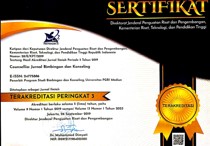Self-efficacy level to recover from addiction in substance users in the center for Drug Rehabilitation
Abstract
Keywords
Full Text:
PDFReferences
Bandura, A (ed). (2009). Self Efficacy in Changing Society. Cambridge: Cambridge University Press
Bart, G. (2012). Maintenance medication for opiate addiction: the foundation of recovery. Journal of addictive diseases, 31(3), 207-225.
Best, D. W., & Lubman, D. I. (2012). The recovery paradigm: A model of hope and change for alcohol and drug addiction. Australian family physician, 41(8), 593.
Buckingham, S. A., Frings, D., & Albery, I. P. (2013). Group membership and social identity in addiction recovery. Psychology of Addictive Behaviors, 27(4), 1132.
Emsley, R., Chiliza, B., Asmal, L., & Harvey, B. H. (2013). The nature of relapse in schizophrenia. BMC psychiatry, 13(1), 50.
Ersche, K. D., Jones, P. S., Williams, G. B., Turton, A. J., Robbins, T. W., & Bullmore, E. T. (2012). Abnormal brain structure implicated in stimulant drug addiction. Science, 335(6068), 601-604.
Geller, S. M., Greenberg, L. S., & Watson, J. C. (2010). Therapist and client perceptions of therapeutic presence: The development of a measure. Psychotherapy Research, 20(5), 599-610.
Groshkova, T., Best, D., & White, W. (2013). The A ssessment of R ecovery C apital: Properties and psychometrics of a measure of addiction recovery strengths. Drug and Alcohol Review, 32(2), 187-194.
Greenfield, B. L., Venner, K. L., Kelly, J. F., Slaymaker, V., & Bryan, A. D. (2012). The impact of depression on abstinence self-efficacy and substance use outcomes among emerging adults in residential treatment. Psychology of Addictive Behaviors, 26(2), 246.
Harrawood, L. K., McClure, C. C., & Nelson, J. (2011). Using experiential activities to prepare counselors-in-training to understand the power of cravings when addressing clients with addiction. Journal of Creativity in Mental Health, 6(2), 105-117.
Horn, G., Barnes, J., Brownsword, R., Deakin, J. F. W., Gilmore, I., Hickman, M., ... & Wolff, J. (2010). Brain science, addiction and drugs. Project Report. The Academy of Medical Sciences, London, UK.
Kadden, R. M., & Litt, M. D. (2011). The role of self-efficacy in the treatment of substance use disorders. Addictive behaviors, 36(12), 1120-1126.
Kandall, S. R. (2010). Women and drug addiction: a historical perspective. Journal of addictive diseases, 29(2), 117-126.
Koob, G. F., & Volkow, N. D. (2016). Neurobiology of addiction: a neurocircuitry analysis. The Lancet Psychiatry, 3(8), 760-773.
Laudet, A. B., & White, W. (2010). What are your priorities right now? Identifying service needs across recovery stages to inform service development. Journal of Substance Abuse Treatment, 38(1), 51-59.
Marsch, L. A. (2012). Leveraging technology to enhance addiction treatment and recovery. Journal of addictive diseases, 31(3), 313-318.
Neale, J., Tompkins, C., Wheeler, C., Finch, E., Marsden, J., Mitcheson, L., ... & Strang, J. (2015). “You’re all going to hate the word ‘recovery’by the end of this”: Service users’ views of measuring addiction recovery. Drugs: education, prevention and policy, 22(1), 26-34.
Perry, J. L., Joseph, J. E., Jiang, Y., Zimmerman, R. S., Kelly, T. H., Darna, M., ... & Bardo, M. T. (2011). Prefrontal cortex and drug abuse vulnerability: translation to prevention and treatment interventions. Brain research reviews, 65(2), 124-149.
Reber, A.S., & Reber, E.S. (2010). Kamus Psikologi. Yogyakarta: Pustaka Pelajar.
Saini, G. K., Gupta, N. D., & Prabhat, K. C. (2013). Drug addiction and periodontal diseases. Journal of Indian Society of Periodontology, 17(5), 587.
Schomerus, G., Corrigan, P. W., Klauer, T., Kuwert, P., Freyberger, H. J., & Lucht, M. (2011). Self-stigma in alcohol dependence: consequences for drinking-refusal self-efficacy. Drug and alcohol dependence, 114(1), 12-17.
Sellman, D. (2010). The 10 most important things known about addiction. Addiction, 105(1), 6-13.
Shen, X. Y., Orson, F. M., & Kosten, T. R. (2012). Vaccines against drug abuse. Clinical Pharmacology & Therapeutics, 91(1), 60-70.
Stevenson, B. (2011). Drug policy, criminal justice, and mass imprisonment. Geneva: Global comission on drug policies.
Supriyanto, A. (2016). Islamic Guidance for Drug Addiction. Jurnal Konseling dan Pendidikan, 4(2), 98-104.
Supriyanto, A. (2017). Rehabilitation Counseling: Concept Assessment Guidance and Counseling For Drugs Abuse. In Prosiding Seminar Bimbingan dan Konseling (Vol. 1, No. 1, pp. 19-30).
Supriyanto, A., & Hendiani, N. (2018). Self Efficacy Scale For People With Drug Abuse Disorders. JKI (Jurnal Konseling Indonesia), 3(2), 57-63.
Tiffany, S. T., Friedman, L., Greenfield, S. F., Hasin, D. S., & Jackson, R. (2012). Beyond drug use: a systematic consideration of other outcomes in evaluations of treatments for substance use disorders. Addiction, 107(4), 709-718.
Volkow, N. D., Baler, R. D., & Goldstein, R. Z. (2011). Addiction: pulling at the neural threads of social behaviors. Neuron, 69(4), 599-602.
Volkow, N., & Morales, M. (2015). The brain on drugs: from reward to addiction. Cell, 162(4), 712-725.
Yoshimura, A., & Higuchi, S. (2015). Danshukai and other support groups in addiction treatment. Textbook of Addiction Treatment: International Perspectives, 1057-1064.
Young, M. E., DeLorenzi, L. D. A., & Cunningham, L. (2011). Using meditation in addiction counseling. Journal of Addictions & Offender Counseling, 32(1‐2), 58-71.
Article Metrics
Abstract has been read : 2291 timesPDF file viewed/downloaded: 0 times
DOI: http://doi.org/10.25273/counsellia.v8i2.2944
Refbacks
- There are currently no refbacks.
Counsellia is Indexed By:
Counsellia Office:
Universitas PGRI Madiun
Program Studi Bimbingan dan Konseling

This work is licensed under a Creative Commons Attribution-NonCommercial-ShareAlike 4.0 International License.














